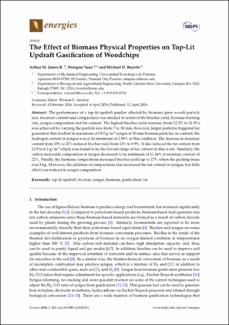| dc.contributor.author | James Rivas, Arthur | |
| dc.contributor.author | Yuan, Wenqiao | |
| dc.contributor.author | Boyette 2, Michael D. | |
| dc.date.accessioned | 2020-03-03T12:50:20Z | |
| dc.date.accessioned | 2020-03-03T12:50:20Z | |
| dc.date.available | 2020-03-03T12:50:20Z | |
| dc.date.available | 2020-03-03T12:50:20Z | |
| dc.date.issued | 2016-04-12 | |
| dc.date.issued | 2016-04-12 | |
| dc.identifier | http://www.mdpi.com/1996-1073/9/4/283 | |
| dc.identifier.other | https://doi.org/10.3390/en9040283 | |
| dc.identifier.uri | https://ridda2.utp.ac.pa/handle/123456789/9573 | |
| dc.identifier.uri | https://ridda2.utp.ac.pa/handle/123456789/9573 | |
| dc.description | The performance of a top-lit updraft gasifier affected by biomass (pine wood) particle size, moisture content and compactness was studied in terms of the biochar yield, biomass burning rate, syngas composition and tar content. The highest biochar yield increase (from 12.2% to 21.8%) was achieved by varying the particle size from 7 to 30 mm, however, larger particles triggered tar generation that reached its maximum of 93.5 g/m3 syngas at 30-mm biomass particles; in contrast, the hydrogen content in syngas was at its minimum of 2.89% at this condition. The increase in moisture content from 10% to 22% reduced biochar yield from 12% to 9.9%. It also reduced the tar content from 12.9 to 6.2 g/m3 which was found to be the lowest range of tar content in this work. Similarly, the carbon monoxide composition in syngas decreased to its minimum of 11.16% at moisture content of 22%. Finally, the biomass compactness increased biochar yield up to 17% when the packing mass was 3 kg. However, the addition of compactness also increased the tar content in syngas, but little effect was noticed in syngas composition. | en_US |
| dc.description.abstract | The performance of a top-lit updraft gasifier affected by biomass (pine wood) particle size, moisture content and compactness was studied in terms of the biochar yield, biomass burning rate, syngas composition and tar content. The highest biochar yield increase (from 12.2% to 21.8%) was achieved by varying the particle size from 7 to 30 mm, however, larger particles triggered tar generation that reached its maximum of 93.5 g/m3 syngas at 30-mm biomass particles; in contrast, the hydrogen content in syngas was at its minimum of 2.89% at this condition. The increase in moisture content from 10% to 22% reduced biochar yield from 12% to 9.9%. It also reduced the tar content from 12.9 to 6.2 g/m3 which was found to be the lowest range of tar content in this work. Similarly, the carbon monoxide composition in syngas decreased to its minimum of 11.16% at moisture content of 22%. Finally, the biomass compactness increased biochar yield up to 17% when the packing mass was 3 kg. However, the addition of compactness also increased the tar content in syngas, but little effect was noticed in syngas composition. | en_US |
| dc.format | application/pdf | |
| dc.language | eng | |
| dc.language.iso | eng | en_US |
| dc.rights | https://creativecommons.org/licenses/by-nc-sa/4.0/ | en_US |
| dc.rights | https://creativecommons.org/licenses/by-nc-sa/4.0/ | |
| dc.rights | info:eu-repo/semantics/openAccess | |
| dc.subject | top-lit updraft | en_US |
| dc.subject | biochar | en_US |
| dc.subject | syngas | en_US |
| dc.subject | biomass | en_US |
| dc.subject | gasification | en_US |
| dc.subject | tar | en_US |
| dc.subject | top-lit updraft | |
| dc.subject | biochar | |
| dc.subject | syngas | |
| dc.subject | biomass | |
| dc.subject | gasification | |
| dc.subject | tar | |
| dc.title | The Effect of Biomass Physical Properties on Top-Lit Updraft Gasification of Woodchips | en_US |
| dc.type | info:eu-repo/semantics/article | en_US |
| dc.type | info:eu-repo/semantics/article | |
| dc.type | info:eu-repo/semantics/publishedVersion | |
